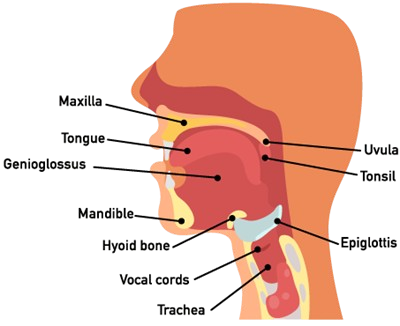The Human Voice.
The sound produced in a person's larynx and uttered through the mouth, as speech or song.
The human voice consists of sound made by a human being using the vocal tract, including talking, singing, laughing, crying, screaming, shouting, humming or yelling.
The human voice frequency is specifically a part of human sound production in which the vocal folds (vocal cords) are the primary sound source.
(Other sound production mechanisms produced from the same general area of the body involve the production of unvoiced consonants, clicks, whistling and whispering.)
Generally speaking, the mechanism for generating the human voice can be subdivided into three parts; the lungs, the vocal folds within the larynx (voice box), and the articulators.
The lungs, the "pump" must produce adequate airflow and air pressure to vibrate vocal folds.
The vocal folds (vocal cords) then vibrate to use airflow from the lungs to create audible pulses that form the laryngeal sound source.
The muscles of the larynx adjust the length and tension of the vocal folds to 'fine-tune' pitch and tone.
The articulators (the parts of the vocal tract above the larynx consisting of tongue, palate, cheek, lips, etc.) articulate and filter the sound emanating from the larynx and to some degree can interact with the laryngeal airflow to strengthen or weaken it as a sound source.
The vocal folds, in combination with the articulators, are capable of producing highly intricate arrays of sound.
The tone of human voice may be modulated to suggest emotions such as anger, surprise, fear, happiness or sadness.
The human voice is used to express emotion, and can also reveal the age and sex of the speaker.
Singers use the human voice as an instrument for creating music.
Voice modulation in spoken language.
Human spoken language makes use of, the ability of almost all people, in a given society to dynamically modulate certain parameters, of the laryngeal voice source, in a consistent manner.
The most important communicative, or phonetic, parameters are the voice pitch, (determined by the vibratory frequency of the vocal folds), and the degree of separation of the vocal folds, referred to as vocal fold adduction (coming together) or abduction (separating).
The ability to vary the abduction or adduction of, the vocal folds quickly has a strong genetic component, since vocal fold adduction has a life-preserving function, in keeping food from passing into the lungs, in addition to the covering action of the epiglottis.
Consequently, the muscles that control this action are among the fastest in the body.
Children can learn to use this action consistently, during speech at an early age, as they learn to speak, the difference between utterances such as "apa", (having an abductory-adductory gesture for the p) as "aba", (having no abductory-adductory gesture).
They can learn to do this well, before the age of two, by listening only to the voices of adults around them, who have voices much different from their own, and even though the laryngeal movements causing these phonetic differentiations are deep in the throat, and not visible to them.
If an abductory movement or adductory movement is strong enough, the vibrations of the vocal folds will stop (or not start).
If the gesture is abductory, and is part of a speech sound, the sound will be called voiceless.
However, voiceless speech sounds are sometimes better identified as containing an abductory gesture, even if the gesture was not strong, enough to stop the vocal folds from vibrating.
This anomalous feature of human voiceless speech sounds is better understood, if it is realized, that it is the change in the spectral qualities of the voice, as abduction proceeds, that is the primary acoustic attribute, that the listener attends to when identifying a voiceless speech sound, and not simply the presence or absence of human voice, (periodic energy).
An adductory gesture is also identified, by the change in voice spectral energy, it produces.
Thus, a speech sound having an adductory gesture may be referred, to as a "glottal stop", even if the vocal fold vibrations, do not entirely stop.
Other aspects of the voice, such as variations in the regularity of vibration, are also used for communication, and are important for the trained voice user to master, but are more rarely used in the formal phonetic code of a spoken language.
Vocal Cord - The Source of Human Voice.
The means of communication is enormously essential, for the well-being of any animal.
Even micro-organisms communicate with each other, by means of chemicals.
Fortunately, our means of communication are far better than that.
We rely on it, every day to interact with others.
As is the case with walking, seeing, etc, we tend to take it, for granted.
The human voice is immensely versatile, and rich, both in range and content.
We use it to laugh, cry, scream, shout, sing and the list goes on.
The human voice produced, by the vocal cord is capable of producing highly intricate sounds.
You can tell, if your mother is angry at you, by her voice.
Some people do one better, and can tell, if people are lying just by their voice.
The Main Parts of Human Voice Production.
Following are the main parts of human voice production:
The power source: Lungs.
The vibrator: The voice box.
The resonator: Throat, nose, mouth, and sinuses.
The Power Source: Lungs.
The lungs here perform the essential function of, supplying adequate airflow, and air pressure in order to vibrate the vocal cord.
When we inhale, we draw air into the lungs.
This air is then exhaled, creating a stream of air, through your wide pipe and throat.
This exciting air provides the energy, to vibrate the vocal cords, in the voice box to produce sound.
If you want to make loud sounds, you have to exhale hard, to create a strong airflow.
The Vibrator: The voice box.
The part of the throat that moves, when you swallow is known as a voice box.
The Voice Box (Larynx) sits, on the top of the wide pipe.
The voice box is a part of the wide pipe, and the air exhaled from your lungs, passes through the voice box.
The vocal cord consists of two tight strings, that open during breathing, and close when you exhale to make a sound.
They vibrate very fast, almost from 100 to 1000 times per second.
You may vary the pitch, which explains the concept of frequency, pitch, etc. by controlling the tension, in the muscles in the voice box.
The vocal cord is also known as a vocal fold.
The vocal cord modulates, the flow of air from the lungs and into it.
The Resonator: Throat, nose, mouth, and sinuses.
Vocal cord by themselves, produces only a buzzing like sound, much like a bee.
Sound is not created, by vocal cords.
Instead, it is created by the interactions of the vibrations created, by your vocal cord, with the muscles and tissues in your mouth, nose, throat and tongue.
When you talk, your tongue darts all around your mouth helping you pronounce complex syllables.
The vibrations are deliberately altered, in our throat, and mouth to produce, the unique human voice.
In below Image, it shows these body parts.
The Human Voice, in the Universe, or in the Space, or in the outside planet Earth.
No, a human voice does not move, in the Universe, or in the Space, or in the outside planet Earth.
The Sound does not travel, in the Universe, or in the Space, or in the outside planet Earth.
The Sound waves travel, through vibrations in a medium, like air, or water, or solid, and cannot travel through empty space.
In the Universe, or in the Space, or in the outside planet Earth, there are no atoms or molecules to carry sound waves, so there is no sound.
The Sound waves lose, energy over time.
As they travel through a medium, causing them to get quieter, and quieter until they disappear.
The Sound waves are reflected, by mediums.
Like walls, pillars, and rocks, which is known as an echo.
Can you hear sound in space.
No, you cannot hear any sounds, in near-empty regions of the space.
The Sound travels, through the vibration of atoms, and molecules in a medium, (such as Air, or Water, or Solid).
In the Universe, or in the Space, or in the outside planet Earth, where there is no Air, Sound has no way, to travel.
Is it possible, to send messages, through brain waves of the human?.
Technical telepathy is the best method.
The electrical nature of the brain allows, not only for sending of signals, but also for the receiving of electrical pulses.
Technical telepathy is the use of technology to communicate thoughts without Sound.
It involves, using brain-computer interfaces (B C I s), to translate brain activity, into signals, that can be transmitted, to another person.
Electroencephalography (E E G): A cap of electrodes is placed, on the head to read brainwaves.
Transcranial magnetic stimulation (TMS): An electromagnet is placed over the head, to stimulate brain activity.
These can be delivered, in a non-invasive way, using a technique called transcranial magnetic stimulation (TMS).
Neural decoding: Technologies that translate thoughts, into written or spoken language.
Potential applications.
Communication: Allowing people, to communicate their thoughts, and feelings, without speech, or signs.
Mobility: Restoring mobility, for paralyzed people, by stimulating muscles directly.
Brain-machine communication: Revolutionizing, how people interact, with machines.
What is the highest brain wave in Humans?.
Gamma brain waves are the fastest brain waves, produced inside human brain.
Although, they can be hard to measure accurately, they tend to measure above 35 Hz, and can oscillate as fast as 100 Hz.
Human brain tends, to produce gamma waves.
How to measure brain activity in humans.
The Human Brain, is difficult to study, not only, because of its inherent complexity.
The billions of neurons, the hundreds or thousands of types of neurons, the trillions of connections.
The Human Brain, also works at a number of different scales, both in the physical sense and in the time domain.
To understand, the human brain’s electrical activity at these scales, no single technology is enough.
As a result, neuroscientists have a suite of tools, at their disposal.
Some of these, such as fMRI and E E G, can be used in humans, because they are non-invasive; they work through, by looking into the skull, But, these tools suffer, from a lack of detail.
To get a more microscopic picture, of neuron activity, researchers turn to human models.
This allows the behaviour of individual neurons, or small groups of neurons, to be analysed in much greater detail.
The main Questions, for which this mission exists.
1. The Human Mouth, and The Human Ears are having, fixed distances, and standard range.
2. The Sound speed is, only 343 meter per second.
3. The Diameter of the Planet Earth, is 12756 killometer, that is 1 crore, 27 lakh, 56 thousand, Meter.
4. How, these Voices or Sounds or Noises are listening, at the same time, that is simultaneously, in every corner of whole World.
5. How, these Voices or Sounds or Noises are listening, by each & every People, inside all the countries of whole World.
6. How, these Voices or Sounds or Noises are listening, by Peoples, in the Universe, or in the Space, or in the outside planet Earth, where no Air or no Water.
7. Why, these Voices or Sounds or Noises are unknown, generating source.
8. Nobody knows, from where generating, these Voices or Sounds or Noises.
9. The Human Eyes are not generating direct sound of visual inputs, and internal verbalization occurs.
10. First Conclusion is, there is no role of, the Human Mouth, and the Human Ears, and the Human Eyes.
11. Only one body part, Human Brain is not having, fixed distances, or standard range.
12. The Human Brain is, no clear boundary, for what, it is capable of.
13. The Human Brain will hold, more than 1 quadrillion pieces of information, That is, 1 0 0 0 0 0 0 0 0 0 0 0 0 0 0 0 pieces of information. Till now, no body has confirmed about human brain's storage capacity.
14. Second Conclusion is, there is definitely role of the Human Brain.
15. There are two ways, to reach our conclusion, One is "Artificial Mode", Second is "Natural Mode".
16. "Artificial Mode" is the way of Electronics chips, transmitters and receivers inside the human brain. Surgically implanted in the skull, and contain electrodes, that creates all Voices or Sounds or Noies from the Human Brain. Another method is, that without knowledge, inserting of electromagnetic chip, inside human body through vein. Through remote control, moving of sensors inside human body parts, and human brain. Artificially controlling of Brain Motor Cortex, through Remote Control, from different places. Another big question arising here. Human technologies inside Earth Planet has till now, particular limitations on modern sciences. So, It may be any technologies, from outside Earth Planet. It can be possible of outer signals, or outer frequencies, or outer vibrations.
17. Third Conclusion is, there is definitely role of Artificial mode of the Human Brain.
18. "Natural Mode" is from the birth of the humans. The Human Brain is the creation of God, inside human body. Till now, nobody has able to create artificial human brain, or no body has able to control natural human brain entirely. Signals inside the human brain are electrical, and chemical signals, that carry information between neurons. The human brain process information, from the senses, and the body, and then translate that information into meaning. Brain waves are electrical signals, include gamma, beta, alpha, theta, and delta waves. Action potentials are electrical signals, that neurons fire across neural networks. Neurotransmitters are chemical signals, that neurons release across synapses, to communicate with each other. Signals travel through Sensory neurons. which are carrying information, from the senses to the brain. Motor neurons are carrying information, from the brain to the muscles, organs, and glands. Interneurons are connecting sensory, and motor neurons. Many signals are processed are Sensory signals, Body Signals. Sensory Signals are come from the senses of Vision, Smell, Listening, Touch, and Taste, which are related to Eyes, Noses, Ears, Fingers, and Tongues. Another sense is called Sixth sense. Is it real. It is only a belief. Yes, the sense of body awareness, called proprioception, is sometimes referred to as the "sixth sense". An ability to know something without using the ordinary five senses. Body signals are coming from inside the body, such as pain, temperature, walking, and heart rate. So, without any machine, the human brain can be work, like a transmitter, receiver, and producing of radio signals. Technical telepathy is the use of technology, to read and transmit thoughts, from one human, to another human. It can be possible. Where science is failing, then its natural mode.
19. Fourth Conclusion is, there is definitely role of Natural mode of the Human Brain. It can be test, by researchers, stopping all artificial methods. If the Transmissions, and the Receivers are continuing after that, then its no way to refuse, the truth of Natural method.
20. Final Conclusion is not yet finalized, for declaration. It is still under Research. Science has no answer, and Researchers are not able, to give final conclusion. Can Humans are able to stop, these invisible Voices, or Sounds, or Noises. This organization giving, an opportunities to all scientists, researchers, and everybody of all countries, to research. That is why, I am donating of "my living Body" & "my living Brain", for scientific research. "To find solutions". "To Stop Invisible Voices listening by each & every people". "To save all peoples of all the countries". "To save our beautiful earth planet". If it is outer signals, from outside Earth Planet, Then how to save, Earth Planet. If It is Natural methods, Then Why? & How? it is happening.
21. This Organization has formed, due to all above Questions, to find answers, and to find solutions.





 Click below to Listen ...
Click below to Listen ...





